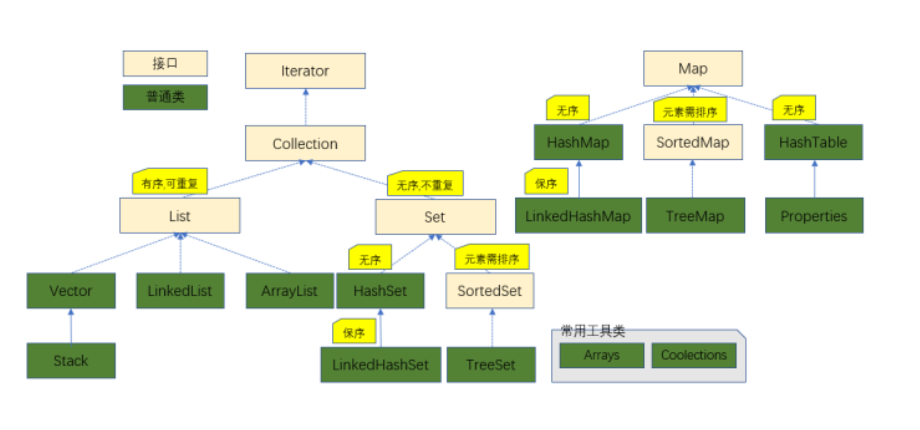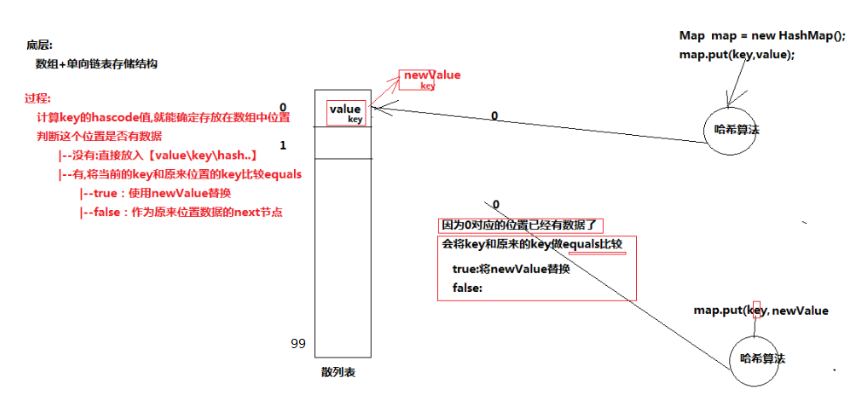集合
含义
容器,位于java.util包下面的类
数组特点
- 大小固定[不会自动扩容]
- 可以存基本数据、引用数据类型
集合特点
示意图

ArrayList
含义
是动态变长的数组
底层
是动态变长的数组
体系结构
常用方法
- isEmpty
- size
- add
- remove
- set
- contains
- get
- clear
- toArray
- addAll 将集合参数的元素逐个加入
- removeAll 将集合参数中的元素中出现的逐个删除
- containsAll 判断集合参数中的元素释放全部都存在
- indexOf 获取元素第一次出现的位置
- lastIndexOf 获取元素最后一次出现的位置
- 等等
泛型
含义
参数化类型(将操作的数据类型放到<>中)
好处
使用场景
案例一
Animal.java
1
2
3
4
5
6
7
8
9
10
11
12
13
14
15
16
17
| public class Animal<T> {
private T content;
public void print(T content){
this.content = content;
System.out.println(content);
}
public void say(){
System.out.println(content);
}
public T getContent(){
return content;
}
}
|
GenericDemo.java
1
2
3
4
5
6
7
8
9
10
11
12
13
14
15
16
17
18
19
20
21
22
23
24
25
26
27
28
29
30
31
32
| public class GenericDemo {
public static void main(String[] args) {
Animal<String> animal = new Animal<String>();
animal.print("11");
animal.print("sdfsdf");
Animal<Integer> other = new Animal<Integer>();
other.print(1);
Integer xx = other.getContent();
}
}
|
案例二
1
2
3
4
5
6
7
8
9
10
11
12
13
14
15
16
17
18
19
20
21
22
23
24
25
26
27
28
| public class _02GenericDemo {
public static void main(String[] args) {
Integer result = getData(true);
System.out.println(result);
String otherReuslt =getData(false);
System.out.println(otherReuslt);
String data = getData("xxx");
}
public static <T> T getData(boolean sign){
if(sign == true){
return (T) new Integer(11);
}else{
return (T) "xx";
}
}
public static <T> T getData(T content){
return content;
}
}
|
案例三
User.java
Student.java
1
2
3
| public class Student extends User {
}
|
_03GenericDemo.java
1
2
3
4
5
6
7
8
9
10
11
12
13
14
15
16
17
18
19
20
21
22
23
24
25
26
27
28
29
30
31
32
33
34
35
36
37
38
39
40
41
42
43
44
45
46
47
48
49
50
| public class _03GenericDemo {
public static void main(String[] args) {
List<Integer> data = new ArrayList<Integer>();
data.add(11);
int result = data.get(0);
System.out.println(result);
List<String> otherData = new ArrayList<String>();
add(data);
add(otherData);
List<User> userData = new ArrayList<User>();
List<Student> studentData = new ArrayList<Student>();
append(userData);
append(studentData);
insert(userData);
insert(studentData);
}
public static void add(List<?> data){
}
public static void append(List<? extends User> data){
}
public static void insert(List<? super Student> data){
}
}
|
Vector
含义
线程安全的ArrayList,使用是上和ArrayList使用差不多
vs ArrayList
- 都实现List接口
- 底层都是采用可变数组存储
- vector是线程安全的
体系结构
常用方法
- add addAll
- remove removeAll
- contains containsAll
- set
- get
- isEmpty
- size
- indexOf lastIndexOf
- toArray
- clear
- 等等
案例
1
2
3
4
5
6
7
8
9
10
11
12
13
14
15
16
17
18
19
20
21
22
23
24
25
26
27
28
29
30
31
32
33
34
35
36
37
38
39
40
| public class VectorDemo {
public static void main(String[] args) {
Vector<String> data = new Vector<>();
data.add("11");
System.out.println(data.get(0));
}
}
|
Stack
含义
栈数据结构
体系
底层
本质采用可变数组
常用方法
案例
1
2
3
4
5
6
7
8
9
10
11
12
13
14
15
16
17
18
19
20
21
22
23
24
25
26
27
28
29
30
31
| public class StackDemo {
public static void main(String[] args) {
Stack<String> stack = new Stack<>();
stack.push("11");
stack.push("22");
stack.push("33");
System.out.println(stack.peek());
System.out.println(stack.pop());
System.out.println(stack.empty());
System.out.println(stack);
}
}
|
LinkedList
含义
JDK提供的类,该类实现双向链表数据结构
示意图

底层
双向链表
体系结构
常用方法
和ArrayList差不多
案例一
1
2
3
4
5
6
7
8
9
10
11
12
13
14
15
16
17
18
19
20
21
22
23
24
25
26
27
28
29
30
31
32
33
34
35
36
37
38
39
40
| public class _01LinkedListDemo {
public static void main(String[] args) {
LinkedList<String> data = new LinkedList<String>();
data.add("11");
data.add("22");
data.add("33");
System.out.println(data.get(0));
}
}
|
案例二
1
2
3
4
5
6
7
8
9
10
11
12
13
14
15
16
17
18
19
20
21
22
23
24
25
26
27
28
29
30
31
32
33
34
35
36
37
38
39
40
41
42
43
44
45
46
47
48
49
50
| public class _02Compare {
public static void main(String[] args) {
add(100000);
}
public static void add(int max){
long start,end;
List<Integer> arrayList = new ArrayList<>();
start = System.currentTimeMillis();
for(int i=0;i<max;i++){
arrayList.add(0,i);
}
end = System.currentTimeMillis();
System.out.println("arrayList的插入时间:"+(end-start));
List<Integer> linkedList = new LinkedList<>();
start = System.currentTimeMillis();
for(int i=0;i<max;i++){
linkedList.add(0,i);
}
end = System.currentTimeMillis();
System.out.println("linkedList的插入时间:"+(end-start));
}
}
|
vs ArrayList
|
ArrayList |
LinkedList |
| 数据结构 |
数组 |
链表 |
| 是否有索引 |
有 |
没有 |
| 根据索引查询 |
快 |
慢(只能遍历后比较位置) |
| 更新 |
快(通过索引快速找到更新) |
慢(只能遍历找到后更新) |
| 删除 |
慢(需要移动位置) |
快(不需要移动位置) |
| 添加 |
慢(需要移动位置) |
快(不需要移动位置) |
单向队列[了解]
特点
FIFO\LILO
案例
1
2
3
4
5
6
7
8
9
10
11
12
13
14
15
16
17
18
19
20
21
22
23
24
25
26
27
28
29
30
31
32
33
34
35
36
37
38
39
40
41
42
43
44
| public class QueueDemo {
public static void main(String[] args) {
Queue<Integer> queue = new LinkedList<>();
queue.add(1);
queue.offer(2);
queue.offer(3);
System.out.println(queue);
queue.remove();
System.out.println(queue);
queue.poll();
System.out.println(queue);
int result = queue.element();
result = queue.peek();
System.out.println(result);
}
}
|
双向队列[了解]
1
2
3
4
5
6
7
8
9
10
11
12
13
14
15
16
17
| public class DequeDemo {
public static void main(String[] args) {
Deque<Integer> data = new LinkedList<>();
}
}
|
HashMap 示意代码
MyHashMap.java
1
2
3
4
5
6
7
8
9
10
11
12
13
14
15
16
17
18
19
20
21
22
23
24
25
26
27
28
29
30
31
32
33
34
35
36
37
38
39
40
41
42
43
44
45
46
47
48
49
50
51
52
53
54
55
56
57
58
59
60
61
62
| public class MyHashMap<K,V> {
private final int INIT_CAPACITY=1000;
private Node<K,V> [] container = new Node[INIT_CAPACITY];
public MyHashMap(){
}
public void put(K key,V value){
int code = key.hashCode()>>2;
Node<K,V> oldNode = container[code];
if(oldNode == null){
Node<K,V> node = new Node<K,V>();
node.hashCode = code;
node.key=key;
node.value = value;
container[code] = node;
}else{
K oldKey = oldNode.key;
if(oldKey.equals(key)){
oldNode.value=value;
}else{
Node<K,V> node = new Node<K,V>();
node.hashCode = code;
node.key=key;
node.value = value;
oldNode.next=node;
}
}
}
public Object get(K key){
int code = (key.hashCode()>>2);
return container[code].value;
}
}
class Node<K,V>{
int hashCode;
K key;
V value;
Node<K,V> next;
}
|
Test.java
1
2
3
4
5
6
7
8
9
10
11
12
13
14
15
16
17
18
19
20
21
22
23
24
25
26
27
28
29
30
31
32
33
34
35
36
37
38
39
40
41
42
43
44
| package com.neu.day08._06map;
public class Test {
public static void main(String[] args) {
MyHashMap<User, String> data = new MyHashMap<>();
User one = new User(100);
data.put(one, "xx");
User two = new User(100);
data.put(two, "yy");
}
}
class User{
int num;
public User(int num){
this.num = num;
}
@Override
public int hashCode() {
final int prime = 31;
int result = 1;
result = prime * result + num;
return result;
}
}
|
HashMap
含义
key-value形式
底层
数组+链表
示意图

体系结构
常用方法
- size
- put
- putAll
- get
- size
- isEmpty
- clear
- containsKey
- containsValue
- remove
- 等等
案例一
1
2
3
4
5
6
7
8
9
10
11
12
13
14
15
16
17
18
19
20
21
22
23
24
25
26
27
28
29
30
31
32
33
34
35
36
37
38
39
40
41
42
43
44
45
46
47
48
49
50
51
| public class _01HashMapDemo {
public static void main(String[] args) {
HashMap<String,String> data = new HashMap<>();
data.put("name","zs");
data.put("age","10");
data.put("address","guangzhou");
System.out.println(data.get("name"));
data.remove("age");
System.out.println(data);
System.out.println(data.containsKey("name"));
System.out.println(data.containsValue("zs"));
System.out.println(data);
Map<String,String> temp = new HashMap<>();
temp.put("color", "red");
temp.put("size", "xl");
data.putAll(temp);
System.out.println(data);
System.out.println(data.size());
}
}
|
案例二
1
2
3
4
5
6
7
8
9
10
11
12
13
14
15
16
17
18
19
20
21
22
23
24
25
26
27
28
29
30
31
32
33
34
35
| public class _02HashMapDemo {
public static void main(String[] args) {
HashMap<String,String> data = new HashMap<>();
data.put("name","zs");
data.put("age","10");
data.put("address","guangzhou");
System.out.println("方式一................");
Set<String> keys = data.keySet();
for(String key : keys){
System.out.println(key+"="+data.get(key));
}
System.out.println("方式二................");
Collection<String> values = data.values();
for(String value : values){
System.out.println(value);
}
System.out.println("方式三................");
Set<Entry<String, String>> entrySet = data.entrySet();
for(Entry<String, String> entry : entrySet){
System.out.println(entry.getKey()+"="+entry.getValue());
}
}
}
|
案例三
验证HashMap是否有序
1
2
3
4
5
6
7
8
9
10
11
12
13
14
15
16
17
18
19
20
| public class _03HashMapDemo {
public static void main(String[] args) {
Map<String,String> data = new HashMap<>();
data.put("33","33");
data.put("hhhhhh","33");
data.put("aa","aaaa");
data.put("xx","xxxx");
data.put("yy","yyyy");
data.put("yy","1000");
data.put("11","11");
data.put("22","22");
System.out.println(data);
}
}
|
LinkedHashMap
含义
有序的hashMap
体系结构
案例
1
2
3
4
5
6
7
8
9
10
11
12
13
14
15
16
17
18
19
20
21
22
23
24
25
26
27
28
| public class _04LinkedHashMap {
public static void main(String[] args) {
Map<String,String> data = new LinkedHashMap<>();
data.put("33","33");
data.put("hhhhhh","33");
data.put("aa","aaaa");
data.put("xx","xxxx");
data.put("yy","yyyy");
data.put("yy","1000");
data.put("11","11");
data.put("22","22");
System.out.println(data);
}
}
|
Hashtable
含义
重量级HashMap,用法和HashMap类似
体系结构
和HashMap的区别
- Hashtable的方法几乎都有synchronized【线程安全】
- HashMap的key和value都是可以为null,Hashtable的key和value都不可以为空
案例
1
2
3
4
5
6
7
8
9
10
11
12
13
14
15
16
17
18
19
20
21
22
23
24
25
26
27
28
29
| public class _05HashtableDemo {
public static void main(String[] args) {
Hashtable<String,String> data = new Hashtable<>();
data.put("xx", "xxxx");
data.put("yy", "yyyy");
data.put("zz", "zzzz");
System.out.println(data);
HashMap<String,String> xx = new HashMap<>();
xx.put(null,null);
}
}
|


